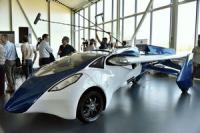-
Germany testing face-recognition software to help police spot terrorists
Germany will be testing facial recognition software at a Berlin train station this summer to see whether it can assist police identify terror suspects more quickly. Volunteers will help police test the software at Berlin’s Suedkreuz station. If the test is successful, the use of the biometric software would be expanded to other locations, and also used to help police identify criminals, not only people suspected of terrorist activities.
-
-
Cybersecurity on the fly
When we think of cybersecurity, we think of applying protection measures to our desktop computers such as installing antivirus programs and using passcodes and pin numbers. Just like our computers, aircraft systems are vulnerable and are not exempt from a cyber-attack. If hacked, some examples of possible cyber effects on aircraft systems can be anything from breakdowns in communication and navigation systems to the more critical systems such as collision avoidance and life support systems.
-
-
Mannequin enhances training, accessibility for TSA officers
Every day, the Transportation Security Administration (TSA) screens more than two million passengers at airports nationwide. To get people to their destinations securely, TSA officers use a combination of technological and manual procedures, including pat-downs. Manual procedures are a key component of the screening process, and are part of various security measures both seen and unseen. Pat-down procedures are used to determine whether prohibited items or other threats to transportation security are concealed on a person. DHS S&T, in collaboration with the TSA Office of Requirements and Capabilities Analysis , is working to develop the Pat-down Accuracy Training Tool, also known as PATT.
-
-
Why banning laptops from airplane cabins doesn’t make sense
Recent reports suggest that terrorists can now create bombs so thin that they cannot be detected by the current X-ray screening that our carry-on bags undergo. In an effort to protect against such threats, the U.S is considering banning laptops and other large electronic devices in the passenger cabins of airplanes flying between Europe and the United States. This would extend a ban already in place on flights from eight Middle Eastern countries. It is tempting to think that any level of cost and inconvenience is sensible if it reduces the risk of an attack even a little. But risks, inherent in flying and even driving, can never be avoided entirely. So when weighing policies that are designed to make us safer, it is important to consider both their costs and potential effectiveness. Unfortunately, whether the benefits justify the costs is too often not the yardstick used by officials determining whether to pursue these types of policies. Instead, it is more likely that political considerations motivate the adoption of restrictive policies, which in the end actually do little to protect citizens’ security.
-
-
Lawsuits filed about electronic privacy, profiling abuses at borders, airports
Earlier this week, two lawsuits were filed in federal court to demand that the Department of Homeland Security (DHS) release information about how federal officials have treated travelers who are Muslim or who are perceived to be Muslim at United States borders, including airports. The lawsuits highlight the numerous recent reports of individuals who are or are perceived to be Muslim having their electronic devices searched while traveling or having their trusted traveler status revoked without explanation.
-
-
Uber picks Dallas, Fort Worth as test cities for flying vehicle network

Uber is looking to North Texas as a testing ground for its initiative to make intra-urban flying vehicle rides a reality. The company announced Tuesday that Dallas and Fort Worth are its first U.S. partner cities for what its dubbing the “Uber Elevate Network.” The company hopes to have the first demonstration of how such a network of flying, hailed vehicles would work in three years. The company also tapped a Dallas real estate development firm and Fort Worth’s Bell Helicopter to develop pick-up and drop-off sites for electric vehicles that would take-off and land vertically.
-
-
U.S. considering extending electronic-device flight ban to European travelers

Passengers flying from the United Kingdom to the United States may soon be barred from carrying their laptops with them, U.K. government officials said Monday. U.K. government sources said they were advised by American security officials that the Trump administration is planning on enforce the electronic device ban on flights from several European countries. The ban, if implemented, will go into effect before the busy summer travel season begins.
-
-
Automated, real-time automobile cow-avoidance device

India has the second largest road network in the world, and a large number of traffic accidents: 1 in 20,000 people die there in a road traffic accident, and 12 in 70,000 are seriously injured in such accidents. India also has a large number of cows roaming streets and roads, and a large number of incidents in which cars run into loitering cows. India researchers have developed a real-time automatic obstacle detection and alert system which determines whether an object near the vehicle is an on-road cow and whether or not its movements represent a risk to the vehicle. If the cow poses a risk to the vehicle, an audio or visual indicator then alerts the driver to apply the brakes.
-
-
Earthquake early warning vital for city transit
Although no one can reliably predict earthquakes, today’s technology is advanced enough to rapidly detect seismic waves as an earthquake begins, calculate the maximum expected shaking, and send alerts to surrounding areas before damage can occur. This technology is known as “earthquake early warning” (EEW). An EEW system called “ShakeAlert” is being developed and tested for the West Coast of the United States.
-
-
DHS S&T opens new explosives detection lab
DHS S&T officially opened a new Test & Evaluation Laboratory building at the Transportation Security Laboratory (TSL) on Wednesday. Located at the William J. Hughes FAA Technical Center in Egg Harbor Township, New Jersey, the new building expands TSL’s reinforced laboratory space for conducting tests of explosives detection systems. TSL is the only laboratory authorized to provide certification and qualification testing of explosives detection systems for the TSA.
-
-
At least nine killed in St. Petersburg metro bombing
At least nine people have been killed and about fifty more injured when a bomb exploded on a train in St. Petersburg. An explosive device went off at 2:20 p.m. local time on a train leaving the Technology Institute station and heading to the Sennaya Ploshchad station. All train travel in the St. Petersburg area has been suspended, and Russian security services found and defused another explosive device at the Ploschad Vosstaniya station.
-
-
New training system improves airport screening efficiency, accuracy
Among the many tasks assigned to Transportation Security Administration (TSA) Transportation Security Officers (TSOs), they must screen every bag boarding commercial aircraft within the United States. Visual search of X-ray images is a repetitive task for the approximately 50,000 screeners employed by TSA, with an often low probability of encountering a threat. TSOs are trained to use perceptual cues such as color, orientation and spatial location of individual items to identify potential threats and differentiate them from non-threat items in the X-ray images of scanned bags. DHS S&T’s Office for Public Safety Research (OPS-R) developed a training system that not only makes TSOs more efficient, but also maintains their accuracy.
-
-
U.S.-bound flights from airports in 8 Muslim-majority countries to ban devices larger than cellphone on board
The Transportation Security Administration (TSA) has instructed airlines to block passengers traveling to the United States from ten airports in eight Muslim-majority countries from bringing laptops, iPads, Kindles, and cameras on board. Passengers boarding U.S.-bound planes at these airports – located in Egypt, Jordan, Kuwait, Morocco, Qatar, Turkey, Saudi Arabia, and the United Arab Emirates — will no longer be allowed to carry with them into the cabin any electronic or electrical device larger than a cellphone. All electronic and electric devices, with the exception of cellphones, will have to be checked.
-
-
Technology experts question device ban
The decision by DHS to ban passengers, boarding U.S.-bound planes at ten airports in eight Muslim-majority countries, from carrying in electric or electronic devices larger than a cellphone into the cabin, is criticized by technology experts who say the new rules appear to be at odds with basic computer science. Another line of criticism suggests that the ban may have less to do with security and more to do with the Trump’s administration’s plan to play hard ball with countries subsidizing major industries in order to gain a competitive advantage over U.S. companies.
-
-
TSA continues to use unscientific, unreliable program blamed for profiling
Thousands of Transportation Security Administration (TSA) officers use so-called “behavior detection” techniques to scrutinize travelers for yawning, whistling, being distracted, arriving late for a flight, and scores of other behaviors that the TSA calls signs of deception or “mal-intent.” The officers then flag certain people for additional screening and questioning. Documents the ACLU has obtained through a Freedom of Information Act lawsuit show that the TSA itself has plenty of material showing that such techniques are not grounded in valid science — and they create an unacceptable risk of racial and religious profiling. Indeed, TSA officers themselves have said that the program has been used to do just that.
-
- All
- Regional
- Water
- Biometrics
- Borders/Immig
- Business
- Cybersecurity
- Detection
- Disasters
- Government
- Infrastructure
- International
- Public health
- Public Safety
- Communication interoperabillity
- Emergency services
- Emergency medical services
- Fire
- First response
- IEDs
- Law Enforcement
- Law Enforcement Technology
- Military technology
- Nonlethal weapons
- Nuclear weapons
- Personal protection equipment
- Police
- Notification /alert systems
- Situational awareness
- Weapons systems
- Sci-Tech
- Sector Reports
- Surveillance
- Transportation
Advertising & Marketing: advertise@newswirepubs.com
Editorial: editor@newswirepubs.com
General: info@newswirepubs.com
2010-2011 © News Wire Publications, LLC News Wire Publications, LLC
220 Old Country Road | Suite 200 | Mineola | New York | 11501
Permissions and Policies
Editorial: editor@newswirepubs.com
General: info@newswirepubs.com
2010-2011 © News Wire Publications, LLC News Wire Publications, LLC
220 Old Country Road | Suite 200 | Mineola | New York | 11501
Permissions and Policies
